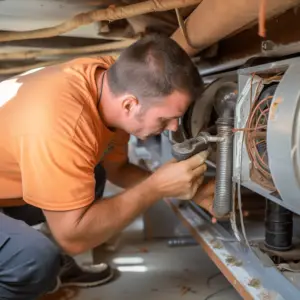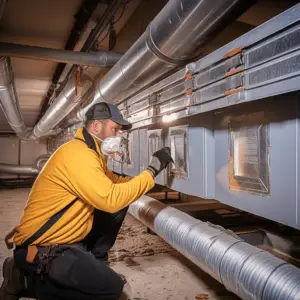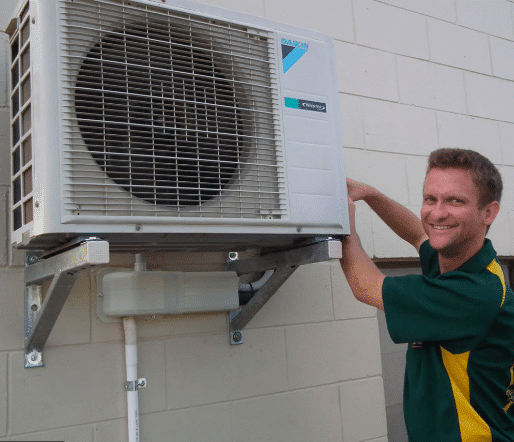HVAC efficiency, Heating, ventilation, and air conditioning systems in our homes or at our places of work play a huge role. They utilize various technologies to control the humidity and temperature and purify the air in the enclosed spaces. Their goal is to offer thermal comfort and suitable indoor air quality.
When an air duct is disconnected, it reduces the energy efficiency of the heating and air conditioning system. Ideally, every bit of conditioned air should go from the furnace to the living space. In extreme cases, the energy lost from disconnected ducts exceeds the cost of the repair materials.
Table of Contents
How to Fix Disconnected Air Duct: Step by Step Guide

Below are the steps on how to fix a disconnected air duct:
- Expose the Disconnected Area of the Air Duct. Unstrap the brackets or straps on either side of the repair area. If the separation has not produced a large gap, putting sealant usually fixes it. If there is a big gap created by a poorly installed or missing S-lock, you must disassemble and rejoin the joint.
- Fix the S-Lock. When necessary, use a utility knife to remove the old mastic from the joint’s edge. Any screws holding the S-lock in place should be removed. Straightening and removing the tabs from the ends of the drives will free them from the connection. Disconnect the joint. Usually, the tension keeps joints from completely separating. Remove the previous S-lock from the joint. With a screwdriver, unlock the S-lock and slip it back into position. The screwdriver-made S-lock gap should accommodate the flat metal on each duct end. Using a hammer, install the drives.
- Seal the Duct Joint. Use a paintbrush to spread 1/8- inch thick layer of mastic across the joint. Let the mastic harden, by following the manufacturer’s recommended dry time before testing your system.
How to Check for Leaks in Air Ducts
For the most accurate analysis, testing ducts for leaks should involve professional techniques. HVAC efficiency procedure, specialized apparatus is connected to the duct system, and airflow measurements are taken to ascertain leaks.
There are several things homeowners can do in addition to the expert testing procedure to find leaky ducts.
Step1: Visually Examine Every Ductwork You have Access to
Check out the visible ducts by ascending into your attic, crawlspace, or basement. Look for visible gaps, disconnections, and tears in each duct portion and connector.
Additionally, search for places where duct tape has been applied. This indicates that duct leaks have probably already been repaired. Since duct tape is an inadequate sealant for leaks, you should also thoroughly examine these areas.
Step 2: Turn on Your HVAC System
Turn on your HVAC system and return to the locations where the ductwork is accessible. Put your hand over the metal connections connecting each duct length. If air hits your hand, there is an air leak, and the connection is loose.
The duct joints are a frequent site for leaks.
Step 3: Slowly Carry a Smoke Pencil or an Intense Stick Along the Ducts
When the HVAC system is running, slowly move a smoke pencil or an incense stick along the ducts while keeping an eye out for movement in the ducts; this indicates that air is fleeing the duct system.
To identify any spots where there are known or suspected duct leaks, mark them by making an arrow on the duct with a grease pencil. After you’ve finished testing for leaks, you can go back to these trouble spots and perform sealing to stop the leak.
What Other Factors Affect Ductwork Efficiency?
A few more problems, besides air loss discovered through leaks, contribute to energy loss and inefficiency from your home’s ducts.
Filthy Vents
Your ductwork accumulates dirt and other airborne debris due to the home’s continuous air circulation. This detritus obstruct airflow. Even if the dirt build-up does not completely cut off the airflow to your open space, it still will restrict free air movement through the ducts.
The solution to filthy ducts is duct cleaning, which removes dirt and debris from the duct system. Air can move more freely through clean ducts, which improves HVAC energy efficiency. Additionally, you profit from improved indoor air quality with fewer contaminants coming into contact with the air supply.
Ducting Without Insulation
Most homes have ductwork running through the rooms that aren’t heated or cooled. The temperature difference between the ductwork and the ambient air in these places may be substantial.
Most of a home’s ductwork passes through the attic, where temperatures may easily reach 130 degrees. This is a 60-degree temperature differential from the air that passes through the ducts, which is cooled to 70 degrees.
Your home’s conditioned air will be at a lower temperature as a result, and your HVAC system will have to work harder to compensate for the loss.
Insulate your ductwork, particularly the ducts that pass through unheated or uncooled spaces. Insulation ensures that the circulating air retains its cooling or heating energy so that you can benefit from it in your open spaces, such as the living room. The basements, crawl spaces, garage, and attic ducts benefit from proper insulation.
What Causes Little or No Airflow to One Vent?

Poorly Connected, Leaky Ductwork
Leaks, cracks, and improperly connected ducts cause the duct system to lose 20 to 30 percent of the air that flows through the duct system.
A hard-to-heat room is one sign that your home or apartment has malfunctioning ducts. HVAC efficiency issue can be resolved by strengthening the ducting, but this is easier said than done since ducts are frequently hidden in walls, attics, ceilings, and basements. Utilize mastic sealant HVAC efficiency discover leaks or poor connections in your duct system.
Disconnected Ducts
An even bigger issue is a disconnected duct, which may result from poor installation. You can reconnect the duct using sheet metal screws and seal the junction if you locate the disconnect.
Kinked or Crushed Ducts
A kinked or crushed duct might also restrict vent airflow. A crushed or kinked duct will tear and need replacement. A kinked duct can be rapidly straightened to restore airflow.
Closed Dampers
Closed or virtually closed dampers are another issue. HVAC efficiency might be self-defeating if a damper isn’t closed or used to control room temperature.


